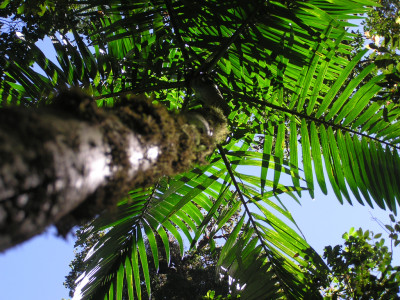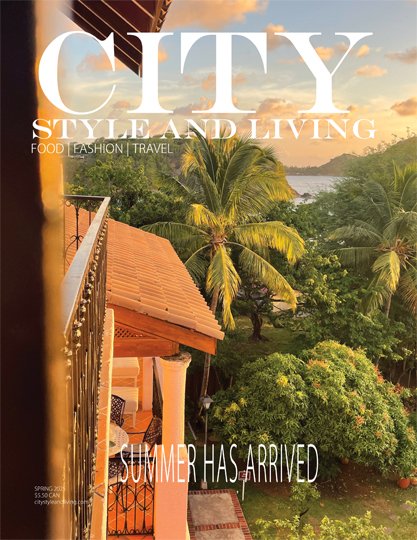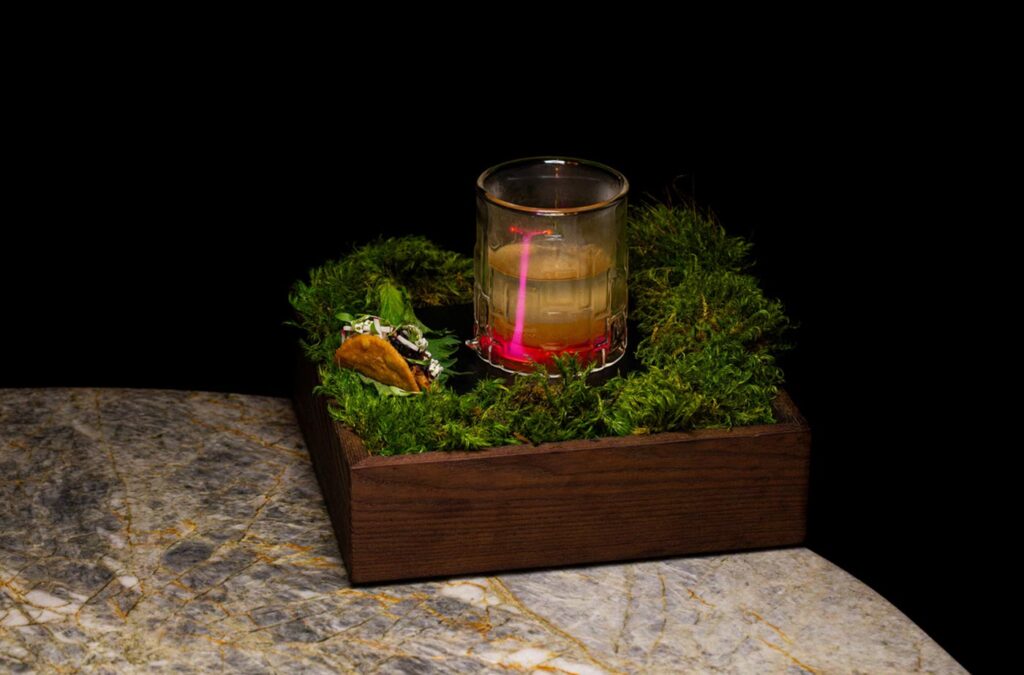







Guido is dressed in mittens, a toque, and a fleece coat. He huddles near the van for warmth and shivers in the morning air. We giggle relentlessly at the antics of a Costa Rican unaccustomed to the cold. That morning, as we had driven down from San Jose toward the Talamanca mountains, Guido had warned us to prepare for the 2000 meter altitude.
As we made our way along the winding roads, the landscape became more and more familiar – what had started out as a distinctly lush, green tropical landscape, slowly morphed into mountainous terrain. It resembled British Columbia during the springtime – coniferous trees, majestic autumnal-coloured leaves, steep cliffs and reddish brown rock. The air had a woodsy scent, and here and there weaving springs and rivers flowed. The deeper into the mountains we went the less settlement there was, until finally, after breathlessly waiting for the van to advance on the last patch of gravel, we had arrived at Savegre Mountain Hotel.
We had come to this place for one reason alone – the Resplendent Quetzal. Like other miraculous events, sightings of the splendid bird are rare; some native Costa Ricans have never even seen the bird in their lifetime. This secretive nature is mostly due to the Quetzal’s erratic flying patterns (from the cloud forests to the lowlands), its breeding habits (only 20 per cent of chicks survive) and its penchant for the wild aguacatillo (avocado) fruit, which grows sparsely at best in Costa Rica.
Despite, or perhaps because of this elusiveness, Aztec and Pre-Columbian cultures revered the bird for centuries. Quetzalcoatl, the feathered serpent god of the Mesoamerican pantheon, his name a combination of Quetzal and Coatl (snake), was associated with Venus, and he was considered the god
of sky and creation. Aztec chiefs wore headdresses with tail feathers from male Quetzals, whose plumes reach up to two metres in length. The feathers were more precious than gold and the birds were considered divine. Even mere sightings of the bird are said to bring prosperity and light. The Resplendent Quetzal is one of the few natural beauties on the planet that are both hypnotizing and beautiful.
So, being endearingly (we hope) superstitious people, and desperately in need of a sign of good fortune, we had booked a trip to Costa Rica and made it public knowledge (to everyone that we would meet) that we were on the hunt (so to speak) for the Resplendent Quetzal. For us, this bird became a symbol.
It was the positive sign we needed. After months of toiling through work situations that were less than enviable, we felt exhausted and depleted. We were hoping that the power of a symbol could transform and bestow good luck.
Our visits to the cities and countryside of Costa Rica had introduced us to increasingly exciting discoveries: a black Madonna in the church of Cartago, the lone remaining ox-cart maker and his grandson hand carving wooden tables in front of our eyes. In Arenal, we walked along a small hiking path, El Silencio that led us to a green mountainous landscape overlooking the cloud covered volcano, bubbling with ferocity. Were it not for the wild orchids that perfumed the air and the keel-billed toucans we had passed on a road nearby we could have been in the rolling hills of home. We had seen twenty foot, half ton crocodiles on the bridge over the Río Tárcoles and cappuccino monkeys, notorious kleptomaniacs, on the beaches of Manuel Antonio. Although we enjoyed every minute of our treks through Costa Rica, as the days progressed, with disdainful good luck wishes offered to us by skeptics, we became increasingly fearful that our search for the Resplendent Quetzal would reach an inevitably sad end.
Thus, on the final days of our trip, panicked that all of our travels had not yet yielded a sighting, we received a phone call from Jorge, our Yoda-like guide and friend in Costa Rica. Being a Tico, he had resourcefully found an area where, he told us, we might have a fighting chance of seeing the Resplendent Quetzal.
Near the main edifice of the Hotel Savegre now, we are in awe as swarms of vibrant jewel-hued hummingbirds, most, smaller than three inches, zip relentlessly from red feeders full with sugar water. As we wait for our guide, we meet an older gentleman whose eyes sparkle with tales of adventure. Guido tells us that he is the owner of all of this splendid beauty. We chat about the strange purple flowers that make a floral fence near a hill, and through Guido’s translation, he tells us that he brought them here from a trip to Patagonia.
When Carlos Chacón, our guide, finally appears, we are surprised to see a young man in his late teens, not the hardened, weathered fellow we had imagined. His slight Spanish accent leads us to believe he’s an American living in Costa Rica. Carlos laughs at this suggestion and shoots us a puzzled look. It turns out that Carlos is the grandson of Don Efraín Chacón, the settler of the San Gerardo de Dota region. Carlos’ brown eyes and blonde hair are reminiscent of his grandfather and when we comment that they resemble, a look of pride comes over him.
If Efraín Chacón had simply settled in San Gerardo de Dota and raised a family on what was once remote, inaccessible land it would be interesting but not particularly noteworthy. Instead, Chacón, has come full circle protecting the land he first cleared under the Costa Rica Homestead Act. Amidst the cloud forest deep in Cerro de la Muerte, the idea of sustainability is being brought to life by the Chacón family.
Beginning in 1954, as land in this pristine valley was cleared for dairy farming, and through various exploits from raising rainbow trout to importing apple seedlings from Israel, the Chacón family sought toexpand their farming operations. The fragile ecosystem where the Chacón family lived, home to mammals, birds and insects was slated to be cut down completely to accommodate the family’s expansion plans. Gazing at a white oak, underneath which three generations of his family stood, Efrain Chacón reflected on the beauty surrounding him and decided instead not to continue with expansion. The plans were shelved and the Savegre Hotel de la Montana has slowly evolved. Among the many ventures into sustainability, the Chacón land is now home to the Quetzal Education and Research Center (QERC). In 1983 a visiting American professor was the catalyst for what would become the QERC, a biological field station that operates as a joint venture between the Chacón family and Southern Nazarene University in Oklahoma. As the highest-altitude biological field station in Central America its mandate is to study the Resplendent Quetzal in its natural habitat. Birders and ecotourists from around the world are lured to this spot which rivals the Monteverde Reserve as one of the best places in Costa Rica for seeing the quetzal.
We walk down to an area that is cleared for the construction of more cabinas. Carlos paces up and down restlessly, mumbling off the names of every single bird he spots. We ask how long Carlos has been a guide, and he tells us that when he was little, he would go out with his uncle to look at birds; and it paid off. In the trees and shrubs we see tanagers and parakeets. We are waiting though, for the real star.
Carlos tells us that the best place to search for the Resplendent Quetzal is in old growth forests and trees that were once inhabited by woodpeckers. A member of the trogon family, Quetzals define the word cute -chubby little birds with iridescent green feathers, a red underbelly, and tufts of hair on their head, suggestive of a punk rocker. We know this by the picture that Carlos shows us from his birding book. He tells us that he had seen the nest of a family of Quetzals near the banks of the Rio Savegre. “Savegre means dangerous water in the dialect of the region,” Carlos informs us, “it is the cleanest river from here to Columbia according to UNESCO.”
Resplendent Quetzals mate for life. “So I guess there are no divorces,” we suggest. Carlos laughs. Then, as if to prove that his resemblance to his grandfather goes beyond looks, Carlos tells us the story of how he rescued new-born chicks that got separated from their parents. “The chicks can fly once they are a week old,” states Carlos. “One of the chicks got lost one day so I had to take him back to the other side of the river so the parents could get him.” Carlos shows us the sound that the bird makes – a repeating whistle. Wheww, whew, whewwwww.
Our gaze gravitates toward some long-tailed Silky-Flycatchers building a nest in the ground. All of a sudden Carlos jolts upward, a smile creeping upon his face. He yelps, “Good news. I see a Quetzal.” As he looks through his binoculars, Carlos quickly sets up the tripod, and looking through the lens, we see a male Quetzal perching high above an aguacatillo tree virtually waiting for us to gawk at him. We are mesmerized, as the little Quetzal remains for us to take in his regal beauty. For twenty minutes we observe his charm and grace, and then suddenly the bird takes flight once more.
Carlos keeps repeating, “you guys are so lucky.” We continue to walk around the Savegre Mountain Hotel, and come upon the apple orchard, delightfully and surprisingly growing on an inclined slope. A former President of Costa Rica, José Figueres, had stayed at the hotel to go sport fishing (the hotel is renowned for a great catch, and 500 kilograms of trout are taken to restaurants in San Jose every week) and had suggested planting temperate fruits rather than the subtropical crops like cocoa and coffee that grow rampant in most other parts of Costa Rica. Carlos tells us with excitement that we must try one of the apples, which have a characteristic sour bite. Jumping up high, hands outstretched and trying for minutes to grab an apple, Carlos finally takes hold of a large red-yellow Anna apple. Biting into the crispy, slightly tart fruit, we continue to walk, hoping to see our little bird once again.
We weave through the trees and Carlos explains that Quetzals don’t venture too far (especially from a prominent food source), and so, would probably stay close by. Making our way along a path, we follow Carlos to some of the deluxe cabins available for guests. The wooden cabins look cozy and invite comparisons, again, to the log-cabins of B.C. A central fireplace and huge windows make the cabins complete. A lady and little girl with long blond hair walk by and we see Carlos darting forward to kiss both. He introduces the two as his mother and sister. He tells us that he has an older sister studying agriculture in Guapiles in the Caribbean side of Costa Rica. When we ask Carlos if he has plans to attend University, Carlos explains that he used to go to high school in Cartago but we can see that his home is in the peaceful mountains surrounded by nature and far away from the city. “I took special courses by correspondence for three years. I was unhappy and I was homesick in Cartago. My place is here.”
As we look through the binoculars for a second time, we are enamored, as we spot another Quetzal. Now, chewing up and spitting up some food, Quetzals, we learn, swallow the aguacatillo whole and then regurgitate it. We are in a little garden behind the kitchen and Carlos begins to show us what a female Resplendent Quetzal looks like for reference. As if on cue, a female flies onto the branch and stays just in time for us to get a quick look. “You can’t get it any better than that because they were on the same tree,” Carlos says. A staff member runs out of the kitchen, and Carlos lends him his binoculars. The staff member had never seen a Quetzal before. Carlos tells us again and again, that we have had amazing luck to have seen so many Quetzals. As we stand outside the kitchen, we laugh until we all have stitches, naming our avian friends Peter, Paul, Carlos Jr. and Angela. When we return home, we learned that Quetzals will perish in captivity; they need the freedom of the open air to survive. Savegre Hotel de la Montana was the breath of fresh air we needed. Though, not much changed in our work situations, we felt utterly recharged. Call it luck, or just plain perspective, it just so happened that having the autonomy to do as we please was liberating.
This article first appeared in the Winter 2007/2008 issue of City Style and Living magazine.












